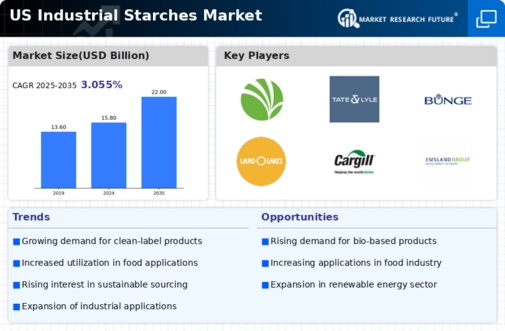Expansion of the Textile Industry
The industrial starches market is benefiting from the expansion of the textile industry, where starches are employed as sizing agents to enhance the strength and finish of fabrics. As the textile market in the US is projected to grow to $70 billion by 2026, the demand for starch-based sizing agents is likely to increase correspondingly. These agents improve the quality of textiles while being biodegradable, aligning with the industry's shift towards sustainable practices. This growth presents a promising opportunity for the industrial starches market to cater to the evolving needs of textile manufacturers.
Increased Utilization in Pharmaceuticals
The industrial starches market is witnessing a surge in utilization within the pharmaceutical industry, where starches serve as excipients in drug formulations. The demand for starch-based excipients is projected to grow at a CAGR of 8% from 2025 to 2030, driven by the need for effective drug delivery systems. Starches enhance the stability and bioavailability of active pharmaceutical ingredients, making them indispensable in the formulation of tablets and capsules. This trend underscores the critical role of industrial starches in advancing pharmaceutical innovations and improving patient outcomes.
Rising Demand for Biodegradable Products
The industrial starches market is experiencing a notable increase in demand for biodegradable products, driven by heightened environmental awareness among consumers and businesses. As regulations tighten around plastic usage, industries are seeking sustainable alternatives. Starches derived from corn, potatoes, and tapioca are being utilized in the production of biodegradable plastics, which are projected to grow at a CAGR of 15% through 2027. This shift not only aligns with sustainability goals but also opens new avenues for the industrial starches market, as manufacturers adapt to meet the evolving preferences of eco-conscious consumers.
Growth in the Adhesives and Coatings Sector
The industrial starches market is significantly influenced by the expansion of the adhesives and coatings sector. Starches are increasingly being used as binders and thickeners in various applications, including construction and automotive industries. The adhesives market alone is expected to reach $60 billion by 2026, with starch-based adhesives gaining traction due to their cost-effectiveness and eco-friendliness. This trend indicates a robust opportunity for the industrial starches market, as manufacturers innovate to create high-performance products that meet the stringent requirements of modern applications.
Technological Innovations in Starch Processing
The industrial starches market is being propelled by technological innovations in starch processing techniques. Advances such as enzymatic modification and high-temperature processing are enhancing the functionality and versatility of starches. These innovations allow for the development of specialty starches that meet specific industry requirements, such as improved solubility and stability. The market for modified starches is expected to grow significantly, with a projected value of $10 billion by 2028. This trend indicates a dynamic shift in the industrial starches market, as manufacturers leverage technology to create tailored solutions for diverse applications.

















Leave a Comment